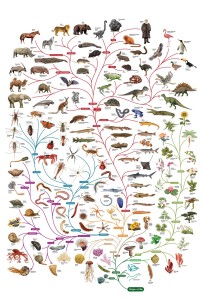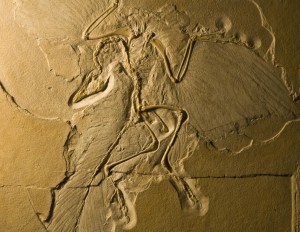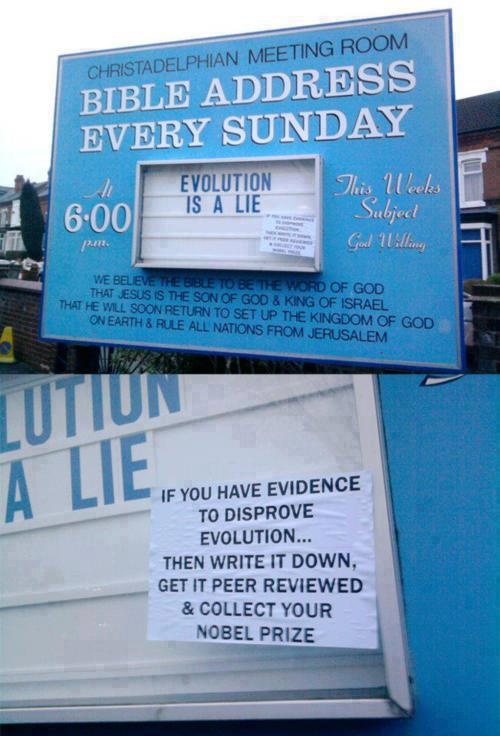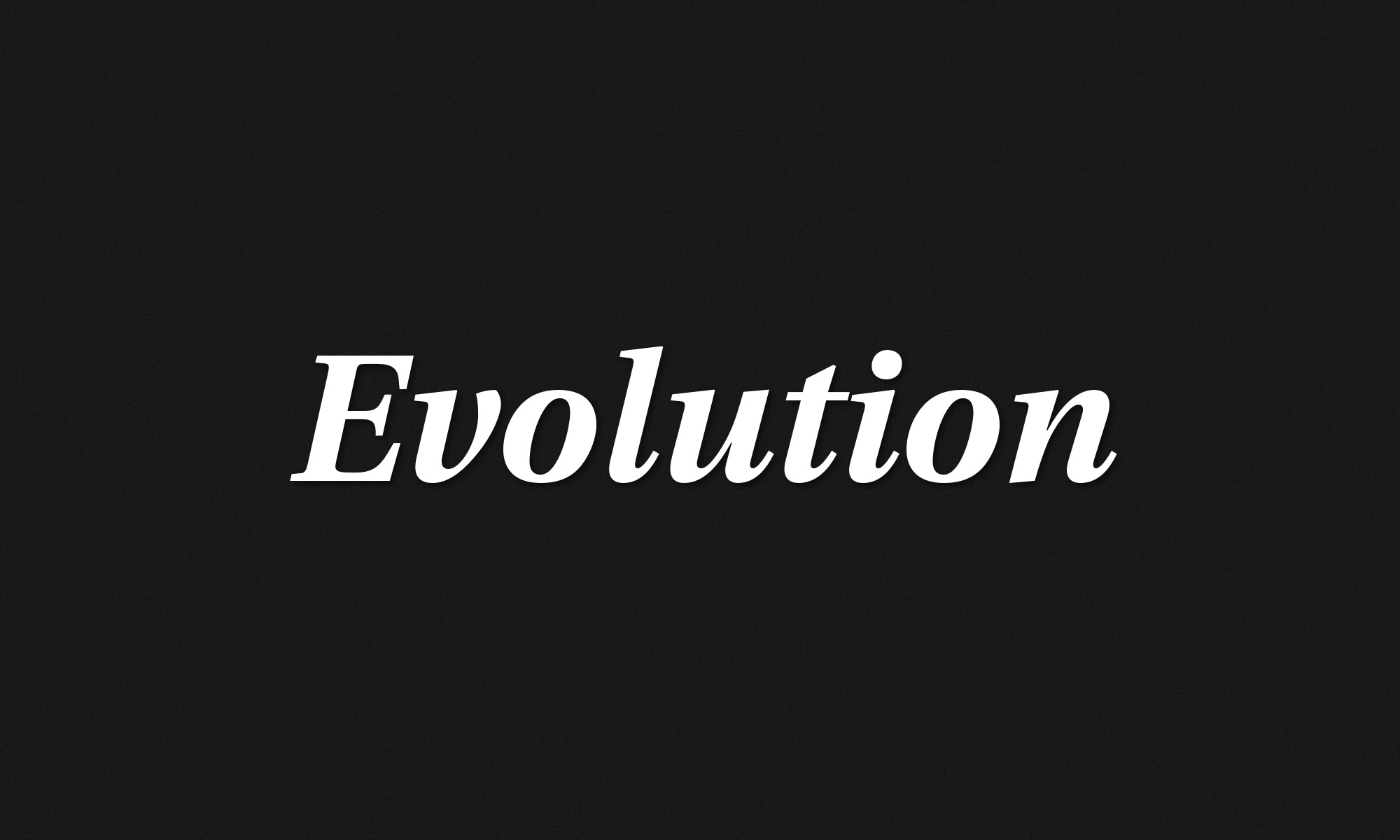Last Updated on 2022-07-08 by Joop Beris
When discussing people of faith, things quickly turn to creation when they learn you’re not a believer. Not believing in the kind and loving god who created me? They seem genuinely shocked to find out that as an atheist, I don’t believe I was created. At least not created in the sense that I believe there was an intelligent process or being behind the creating, someone to design all the bits that make up a human. Surely I can’t believe in evolution? As it turns out, many people don’t accept evolution because they have terribly wrong ideas about what the theory of evolution is and what it says about life on Earth.
Fallacy 1: Evolution is just a theory
One often heard claim from the faithful is that evolution is just a theory, it’s not something that’s been proven. This is partly true, the theory of evolution is “just” a theory in the same sense that the theory of gravity is “just” a theory. Nobody would seriously claim that gravity is only a theory and that it is unproven. Yet this is what believers claim about evolution. They do that because they don’t understand what the term theory means when used in a scientific context. In science, the word theory doesn’t refer to an idea or a thought that someone once had. This may be the starting point of a theory. What in every day speech is called a theory, scientists would call a hunch or a notion. Within the realms of science, the word theory refers to a well-substantiated explanation of some aspect of the natural world, acquired through the scientific method and repeatedly tested and confirmed through observation and experimentation. It’s not something that someone wrote on the back of a beer coaster.
So what about the second part, has the theory of evolution been scientifically accepted as valid? Yes, it has! The theory of evolution is an accepted and established scientific theory, just like gravity. There are virtually no serious scientists that contend that evolution is false, though there is still debate about how evolution works in specific details. As a matter of fact, many scientific bodies have issued statements in which they explicitly make it clear that they reject the religious explanation of intelligent design in favour of the theory of evolution.
Fallacy 2: There is no evidence for evolution
Often heard in conjunction with the fallacy above, believers of religion claim there is no evidence for evolution, so it is just another belief. They are gravely mistaken. There is a huge body of evidence supporting evolution, as for instance P. Z. Meyers sums up nicely here. The University of Berkeley has also compiled a list of articles that conclusively prove that evolution is real and that it explains phenomenon witnessed in the natural world. They actually have a section called “Understanding Evolution” on their website, complete with examples, teaching resources and more. Here another 4 pillars supporting evolution. There is more here and here. If you do not wish to check out any of these linked resources, do yourself at least the favour of checking out this easily understood video that explains why the case for evolution is as strong as it is.
Fallacy 3: Micro-evolution exists, but not macro-evolution
Commonly heard from religious people who don’t dismiss the fact that organisms change over time but reject the idea that one species can change into another because god created all the animals as they are. Micro-evolution is defined as evolution below the species level, while macro-evolution is evolution at the species level or above. People supporting this argument are perfectly okay admitting that insects can evolve to become resistant to pesticides or bacteria to antibiotics. They are also okay with people becoming taller, etcetera What they will not admit to is that one species can change into another species. Or, to paraphrase plenty a theist: “I’ve never seen a pig give birth to a horse, so evolution is nonsense”.
One has to understand that macro-evolution is not a completely different process than micro-evolution. The major difference is just one of time. Over time, lots of tiny changes pile up, leading to major changes. Changes so fundamental, that we can speak of a new species. It is intellectually dishonest to claim that tiny changes are possible but that tiny change upon tiny change over a long enough period can not lead to big changes. Creationists like to use this claim in debates nonetheless. They argue that science has never witnessed one species become another so evolution is just another belief. What they ironically seem to miss, is that nobody witnessed creation either so by using this argument, they invalidate their own argument.
There is a commonly held misconception that a speciation event (one species becoming another) has never been observed by science. While pigs don’t give birth to horses (evolution doesn’t work like that, by the way), science has indeed observed and even replicated speciation events. There is a list of observed speciation events here and here. These are verified events and well documented. All that is needed is for people to read up on them but this is something many creationists simply refuse to do.
Fallacy 4: Evolution can’t explain the beginning of life

This is absolutely correct. Mind you, Charles Darwin didn’t have that in mind when he discovered the process of evolution. Darwin’s theory of evolution describes how organisms change over time. In order for evolution to work on organisms, there must first be organisms. So the fact that the theory of evolution doesn’t explain how life began, is hardly a surprise and certainly not a valid refutation. How life began on Earth is probably best left to the field of biochemistry, not evolutionary biology.
Fallacy 5: Random chance can never create something as complex as…
Using this as an argument simply means you do not understand the theory of evolution. The process of evolution isn’t some kind of lottery. Evolution never thinks “let’s try a pair of bat wings today”. Instead, evolution works by the mechanisms of natural selection, mutation, genetic drift, genetic hitch-hiking and gene-flow. For more information, Wikipedia has a good article. Evolution doesn’t arbitrarily change things in an individual organism. Instead each organism exists in an environment where it is continuously subjected to various factors that influence its chance to pass on its genes to a future generation. Any factors that cause an animal to not have offspring, eliminate genetic material from the available pool.
People arguing for creation, often refer to a quote of Charles Darwin, which goes as follows: “To suppose that the eye […] could have been formed by natural selection, seems, I freely confess, absurd in the highest degree.” Reading this, it sounds as though Darwin had serious doubts about his own theory. Creationists have coined the phrase “irreducible complexity”, meaning a single system which is composed of several interacting parts that contribute to the basic function, and where the removal of any one of the parts causes the system to effectively cease functioning. Or to put it simply: what good is half an eye?
However, the quote from Darwin above is taken out of context. Notice that Darwin writes “seems absurd in the highest degree”. Below are the sentences following that quote:
When it was first said that the sun stood still and the world turned round, the common sense of mankind declared the doctrine false; but the old saying of Vox populi, vox Dei, as every philosopher knows, cannot be trusted in science. Reason tells me, that if numerous gradations from a simple and imperfect eye to one complex and perfect can be shown to exist, each grade being useful to its possessor, as is certainly the case; if further, the eye ever varies and the variations be inherited, as is likewise certainly the case and if such variations should be useful to any animal under changing conditions of life, then the difficulty of believing that a perfect and complex eye could be formed by natural selection, though insuperable by our imagination, should not be considered as subversive of the theory.
So far from expressing doubt about his own theory, Darwin was arguing that while it may seem unrealistic that certain highly specialised traits of an organism evolved naturally, they nevertheless have done so. Fortunately, these days the notion of irreducible complexity has been classified as pseudo-science, having been successfully refuted.
Fallacy 6: Evolution violates the 2nd law of thermodynamics
This is probably my favourite fallacy because it shows that the person making the claim not only doesn’t understand evolution, he or she also fails at physics. The 2nd law of thermodynamics states the following: “No process is possible in which the sole result is the transfer of energy from a cooler to a hotter body”. This doesn’t seem immediately relevant but the 2nd law is often phrased as follows: “The entropy of a closed system cannot decrease.” Entropy refers to the amount of unusable energy in a system and usually corresponds to chaos or randomness. The creationist mistakenly claim that since things proceed naturally from order to disorder and evolution goes from disorder to order, evolution can not be true.
What they are forgetting is that the Earth is not a closed system. We are constantly bombarded from outer space by heat (energy) from the sun, by cosmic particles and even by meteorites. Earth isn’t a lab experiment with carefully controlled conditions, it’s the exact opposite. Furthermore, the 2nd law of thermodynamics states that the total amount of entropy can’t decrease so it is quite possible for entropy to decrease at point A as long as it increases at point B. With all the energy generation, accumulation and consumption by organisms on Earth and things going on in the vastness of outer space, it is nonsense to claim that evolution violates the 2nd law. One supernova creates more entropy than all the supposed order created by evolution here on Earth.
Supposed order? Yes. Evolution does not create order out of chaos and people who claim it does, simply don’t understand it. Evolution only causes small changes between different generations of an organism. It does not gather up a bunch of random parts and builds a giraffe. Small changes over time do no violate any laws of nature or physics.
Fallacy 7: There are no transitional fossils
Creationists argue that if evolution were true, we would find evidence for it in the fossil record in the form of organisms that were caught in transition, halfway between two species. Darwin himself addressed this matter, writing:
Why then is not every geological formation and every stratum full of such intermediate links? Geology assuredly does not reveal any such finely graduated organic chain; and this, perhaps, is the most obvious and gravest objection which can be urged against my theory. The explanation lies, as I believe, in the extreme imperfection of the geological record. – Charles Darwin (1859), The Origin of Species, p. 280

Darwin explained the apparent lack of transitional fossils by blaming the geological record and indeed, fossils do not form easily so they are relatively rare. However, it wasn’t long until the theory of evolution got a kick in the pants by the discovery of Archaeopteryx in 1861. Suddenly, there was a beautifully preserved specimen, showing both reptilian and birdlike traits. It was almost as if it was caught mid-evolution.
Since then, the field of palaeontology has discovered many more transitional fossils. See for yourself on this Wikipedia page. Claiming that there are no transitional fossils, is simply not true.
It is important to remember that the classification of organisms into species is something that humans do, it’s not a natural distinction. There is an entire science devoted to this process of classification, called taxonomy. So while a transitional fossil may look to us like it is half bird, half reptile like Archaeopteryx does, we should not forget that it was still a fully functional animal in its own right. It was not “on its way to become a bird” or “waiting to be fully evolved”. Evolution is a process that has no guiding principle and no plan. There is no consciousness behind this process. Evolution wasn’t “building a bird” and Archaeopteryx was not a stepping stone in this process except through human eyes, looking back through the fossil record. For a more in depth article about how evolution works, please see here.
Conclusion
I’ve examined 7 fallacies about Darwin’s theory of evolution and hopefully demonstrated successfully why these are indeed fallacies. None of these refute even an aspect of the theory of evolution and after reading this article and the links provided, hopefully the reader will accept that evolution is indeed real and not some unproven fantasy of a man with a beard. As a disclaimer, I should note that I am not a biologist and not even close to an expert on evolution so if you have any additions or have found any errors in what I have written, please contact me with corrections. Arguments for creation myths do not qualify, sorry.



[…] wrong statement. Evolution is an accepted scientific theory and a scientific fact but some theists don’t want to understand that, it seems. Theists love to attack evolution though they seem not to understand that even if they […]
Joop. Bravo! Despite not being a biologist, as you say, you did an excellent job of showing that evolution fallacies as espoused by creationists – are not fallacies at all. And though evolution is not my main field of expertise, I have a significant background in the study and teaching of paleontology and evolutionary science. I’d like to go through your responses to the fallacies if I might.
1. Theory. Agree. Those who do not understand what a theory means clearly don’t understand science or how it works. Plate tectonics is considered a theory too.Theories are based on evidence and data. If those support the theory, which they do for both evolution and plate tectonics – then they are considered valid.
2. No evidence for evolution. As you state, there is a large body of evidence supporting evolution. Absolutely! I’ve seen it, I’ve studied it.
3. Well done arguments. Evolution is evolution whether it is micro or macro – there is no distinction. If creationists believe that micro-evolution exists, by default they are admitting macro-evolution exists as well. Can’t have it both ways. Either both exist or neither exists. In addition, just where is that boundary between micro- and macro-evolution? Love to have a creationist point that out to me.
4. Agree. Evolution does not have to prove the origin of life. It is a study of organisms through time and the changes that have occurred to organisms through time. Changes on the Earth over time, like climate, plate movement, environmental changes on both on the land and in the oceans, catastrophic events – all of those are in part driving forces of evolution. Adapt or die. Evolution is an extremely complex process, and the details are probably much too difficult for creationists to understand anyway, even if they were open to listening to them – which I know from experience they are not.
5. Random chance. Agree again, well said. I touched on some of your post in 5 in my reply to 4. It is not difficult at all to see the fossil record shows the evolution of eyes through time (that is, if one is willing to look at the record and be open to what it shows). Eyes are tightly tied to ecosystems. There were many trilobites species with eyes, some of them quite complex, and there were also trilobites that had no eyes – why – because they occupied niches and lifestyles that either required eyes or complex eyes, or they occupied niches and lifestyles that did not require eyes, and those trilobites without eyes had other means of adaptation to their environment. The changes of trilobites throughout the Paleozoic alone is enough evidence to clearly support evolutionary “theory.” And the evolution of trilobites shows evolution does not work like a “lottery” as you aptly stated. To not see that complexity can be formed through evolutionary change is a denial of the facts (both what is seen in the fossil record and what is seen in today’s organisms). And the “half an eye” statement that creationists often use only shows their ignorance of science.
6. Entropy. I love how you state it shows the person doesn’t understand both evolution and physics. That gave me a good laugh. Since entropy is not a strong point for me, I won’t add anything, but you clearly show that evolution does not violate the 2nd law of thermodynamics, and those that use that argument, well, they neither understand .evol . . .
7. Transitional fossils. That you pointed out taxonomy is important to your arguments. Organisms don’t classify themselves – we classify them based on a number of biological criteria. I think that is either missed, misunderstood, or completely ignored by creationists. There are more transitional forms being found every year. The creationist argument of “no transitional fossils” is based on, once again, a lack of understanding of science, the scientific method, data, and evidence, among other things. And I’d like to add to your statement about fossils being rare. Most of the organisms that ever lived on this planet – >99.99999% or so, never made it into the fossil record. Fossilization is a rare process. In addition, we are missing a huge amount of the rock record because of plate tectonics, erosion, weathering, sediment recycling, etc. The number of unconformities in the rock record – angular unconformities, nonconformities,, disconformities, and paraconformities – are immense, so to say we have a continuous rock record over any particular period of geologic time is likely erroneous. As well, I have studied bedrock over miles of stratigraphic sections, and the majority of the rocks typically have no fossils at all. The majority.
Finally, the creationist belief that Noah’s flood created the fossil record – now that is a fallacy, but that is something for another day. Thanks again for a great post!!
Hi Jim, thanks again for a lengthy reply and your words of praise. It means a lot to me to have someone with a background like yours endorse my blog post. I am indeed no biologist, just an interested layman so it’s good to hear that my understanding is at least somewhat correct.
Thank you for your additions and clarifications. Much appreciated!
If you see any errors, please let me know as well.
Hi Joop. I really didn’t see anything in your blog about the fallacies of evolution as being incorrect. I just wanted to add some more details in support of your arguments. I used to post in a forum that had many Young Earth Creationists in it. What a frustrating time that was. No matter what evidence I showed, they would counter with garbage arguments. They would often viciously attack my posts, and I would, sometimes very sarcastically if they really angered me, respond to their posts with more science and more evidence and a lot of questions that typically went unanswered. As a geologist, I was despised. I finally called it quits when I challenged a YEC to actually go out and look at the rocks to either confirm or refute what I was arguing, and his reply was, “I’m fine just sitting in my chair and looking out my window. I know you are wrong and I am right. I don’t need to prove anything to you.”
Will be glad to point out any errors if I see them in your posts. None so far. I enjoy your posts, and I’m glad I came across them during a Google search. Keep up the good work.
Hi Jim,
Well, that’s great to hear. The YECs can be a tiresome bunch, I know. They’re not willing to honestly examine evidence because they already know the truth. I actually started writing a lot of the atheism related blog posts because I got tired of explaining the same things over and over again on twitter, for instance. But even after sending them a link to a relevant post, most of them simply don’t bother to read it. And what evidence can you present to a person who doesn’t value evidence?
Yes, if you see something that needs correcting or simply could use more detail or better phrasing, please let me know!
And again, thanks for the kind words. 🙂
Hi Joop,
More than glad to do that for you. One of my favs was to get the YEC to defend the Universe being a perfect creation by god. Then I’d bring up novas and supernovas. It would go something like this: 6000 years, eh? Well, it appears god’s universe isn’t all that perfect then, since some of his stars can’t even make it for 6,000 years. Did he plan that? Seems like a pretty lousy design to me. He really spent the time to make trillions of stars, and some of them have already exploded? Wow, impressive. Or perhaps god isn’t all that perfect either. Maybe he had no idea what he was doing. So which is it – an imperfect god or an imperfect universe? Or both? Tell me, when should we expect the sun to go off? How much time do we have left? I’d really like to get some answers here. I feel I deserve to know.
Typical reply – either none – or some reply about me being an evil atheist or similar.
Much appreciated, thank you!
I always try to remember that even if you can’t convince your interlocutor, you may be able to convince or sow a seed of doubt with others who are listening in. If even one person begins to honestly examine why he/she believes something without evidence, it’s worth it.
I agree. When I didn’t get replies or it was an answer that didn’t have anything to do with the topic, I knew I shook something up. I usually asked a lot of questions. And I know this example was bold and full of sarcasm, but one like this would usually be a last resort after I had posted a dozen others in a more scientific tone. And I always said early on I was open and would consider whatever they had to say. And I was. But I rarely got the same from them. Hope you are correct and that maybe a few or other readers started to seriously look at what they believed. Will never know.
Hi Joop
And kind of a final note. I learned several things. The first was that because I brought up geological arguments, I was immediately called an atheist. Much to their dismay, I suspect, I always replied with, what makes you think I’m an atheist? How do you know that? I always left them hanging on that one – on purpose. The second was they relied totally on what Ham wrote. Few thoughts of their own. Third, I learned I had a much better grasp of the Bible than they did. And lastly, the more evidence I used, the more I intimidated them, which I knew when they didn’t respond to certain arguments even after repeated times of asking them to respond. Let me know at any time if I can be of assistance to you.
[…] an ape. Species go from one form to another but always more complex, always more specialized. While this isn’t how evolution works, recently I have been wondering if this is true and if not, if we may be the perfect example of […]
[…] "Does God Exist? – Many absolute proofs!" – Random musings, rambling opinions on Evolution theory fallacies […]
[…] Next, we go after evolution because apparently the question of Gods’ existence is closely tied to the question of how life began. We hear arguments as “evolution requires more faith than believing in God and no true facts have been found to support it”. That’s an often heard fallacy among creationists and it’s simply not true. See an earlier article on this blog for more. […]
[…] Is there any evidence for creation? | Random musings, rambling opinions on Evolution theory fallacies […]
[…] Evolution theory fallacies […]